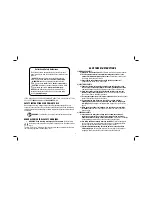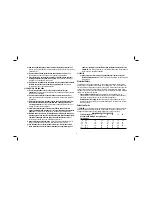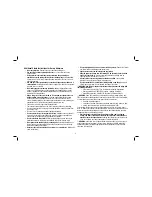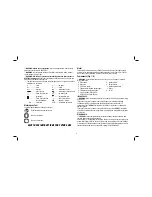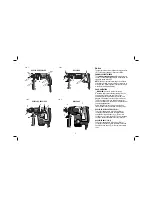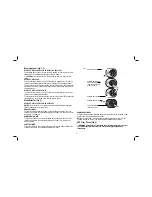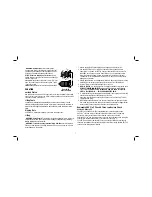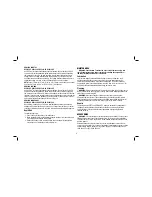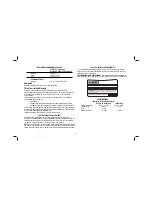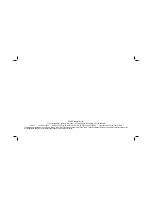
7
WARNING:
Burn Hazard.
ALWAYS wear gloves
FIG. 6
D25124-XE,
D25314-XE ONLY
J
M
L
K
when changing bits. Accessible metal parts on the tool
and bits may get extremely hot during operation. Small
bits of broken material may damage bare hands.
NOTICE:
Do not use chipping bits in this tool.
Using
chipping bits may cause the tool to bind-up and damage
to the tool may occur.
To insert bit,
insert shank of bit about 19 mm (3/4") into
chuck. Push and rotate bit until it locks in place. The bit
will be securely held.
To release bit,
pull the sleeve (J) back and remove the bit.
OPERATION
Overload Clutch
If the drill bit becomes jammed or caught, the drive to the drill spindle is interrupted.
Because of the forces that occur as a result, always hold the machine securely with
both hands and take a firm stance.
Drilling Tools
The machine is intended for hammerdrilling in concrete, brick and stone. It is also
suitable for drilling without impact in wood, metal, ceramic and plastic. Machines with
electronic control and right/left rotation are also suitable for screw driving and thread
cutting.
Chipping Tools
The machine is intended for chipping in concrete, brick and stone.
Drilling
WARNING: Shock Hazard.
To reduce the risk of serious personal injury, turn tool off
and disconnect tool from power source before making any adjustments or removing/
installing attachments or accessories.
WARNING: To reduce the risk of personal injury, ALWAYS
ensure workpiece is
anchored or clamped firmly. If drilling thin material, use a wood “back-up” block to
prevent damage to the material.
1. Always unplug the drill when attaching or changing bits or accessories.
2. Use sharp drill bits only. For WOOD, use twist drill bits, spade bits, power
auger bits, or hole saws. For METAL, use steel twist drill bits or hole saws. For
MASONRY, such as brick, cement, cinder block, etc., use carbide-tipped bits
rated for percussion drilling. Be sure the material to be drilled is anchored or
clamped firmly. If drilling thin material, use a wood “back-up” block to prevent
damage to the material.
3. Always apply pressure in a straight line with the bit. Use enough pressure to keep
drill biting, but do not push hard enough to stall the motor or deflect the bit.
4. Hold tool firmly to control the twisting action of the drill.
5.
IF DRILL STALLS,
it is usually because it is being overloaded or improperly used.
RELEASE TRIGGER IMMEDIATELY,
remove drill bit from work, and determine
cause of stalling.
DO NOT CLICK TRIGGER ON AND OFF IN AN AT TEMPT TO
START A STALLED DRILL — THIS CAN DAMAGE THE DRILL.
6. To minimize stalling or breaking through the material, reduce pressure on drill and
ease the bit through the last fractional part of the hole.
7. Keep the motor running when pulling the bit back out of a drilled hole. This will
help prevent jamming.
8. With variable speed drills there is no need to center punch the point to be drilled.
Use a slow speed to start the hole and accelerate by squeezing the trigger harder
when the hole is deep enough to drill without the bit skipping out.
Removable SDS Plus
®
Chuck & Three Jaw Keyless Chuck
D25124-XE, D25314-XE
The D25124-XE and D25314-XE are equipped with a removable quick change
SDS Plus
®
chuck as well as a removable three jaw keyless chuck. The hammer
mechanism does not function when the three jaw keyless chuck is used.
Both the SDS Plus
®
and three jaw keyless chuck can be easily removed by turning the
collar (K) into the unlocked position (L) to release the chuck (Fig. 6).
The SDS Plus
®
and three jaw keyless chuck can be easily attached by inserting the
chuck into the spindle of the tool and turning the collar to the locked position (M). The
chuck will click when properly installed.
Summary of Contents for HEAVY-DUTY SDS PLUS D25123-XE
Page 2: ......


